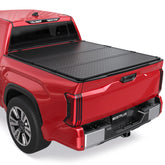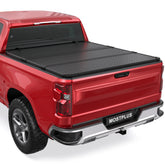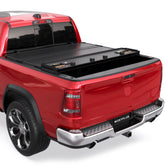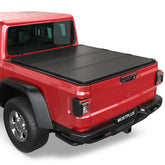Top 5 specs to look for when shopping for LED headlights
These are the top five specs you should look for when shopping for LED headlights: brightness, beam pattern, color temperature, fit, and lifespan.
Spec 1: Brightness
What should you look for in terms of brightness?
Like we said, you can get different looks from the same bulb if you measure it from different spots. It's important to know how far, how high, and how close to the center the meter is. But the total lumens of an LED headlight is determined when it is designed and manufactured. That's why you see lumens instead of lux in ratings and marketing spots. Remember, total lumens is how much light an LED headlight can produce; lux is the reality of how good your nighttime driving experience would be.

Spec 2: Beam pattern
What is beam pattern?
This is a description of how your LED spotlight emits light. The SAE regulates this proper angle, which can be summed up in one word: safe. Safe for you and other drivers. For you, you want to see the road ahead clearly; that's usually where you want to set a lux meter. For other drivers, SAE guidelines don't allow the light to exceed a certain angle that would dazzle other drivers.
What angle should my headlight be at according to SAE guidelines?
The reference point should be at the same height as the optical center if the vehicle's headlight center is less than 36 inches above the ground. If the optical center is more than 36 inches, the reference point should be two inches below the optical center of the headlight.
How do you properly install a bulb to get a good beam pattern?
It depends on the type of LED headlight and the type of headlight housing you have.
Are LEDs safe for automotive use?
The answer is yes and no. There's nothing wrong with the LED technology itself, as long as the light is properly designed for the headlight housing you're installing it in. You can even get a bad beam pattern from a poorly designed halogen bulb, just like your engine can run smoothly with the right type of motor oil from different brands, but will not work properly with the wrong formula oil, even from an OEM oil manufacturer.

What's wrong with many LED headlights?
In order for a replacement light source to work as well as the stock bulb and provide a good, clear beam pattern, we need to design the replacement light as close to the original as possible. Although there are many high-power, high-efficiency LED chips available, only a few are suitable for use in LED headlights. And often we choose to design and customize LED chips to ensure the design is as close as possible to the original bulbs.
Are LED headlights better for reflector housing or projector housing?
First, let's break down the different packages. For those fixtures that have the wrong LED chips or are improperly or inefficiently designed, the lens in a projector housing will be able to correct most of the light direction from an improperly designed LED fixture. But you will still get a lot of dark spots due to the design differences with halogen light. A reflector housing is less forgiving of light from an improperly designed bulb, spilling out everywhere but the road in front of you. If the light source is properly designed for its beam characteristics and the housing, adjusting the LED light to be vertical will optimize the beam pattern.
What should I look for when shopping for LED headlights in terms of beam pattern?
Keep in mind that not all LED chips are suitable for use in LED headlights due to their shape and size. Look for headlights with a proper lighting design that is as close as possible to the original stock halogen bulb, including both the shape of the LED chip and the depth of the chip into the housing once installed. Finally, an adjustable bulb will help you optimize the beam pattern.
Spec 3: Color Temperature
What is color temperature?
For the automotive lighting industry, one of the most important measures of light quality is color temperature. A higher color temperature such as 10,000 Kelvin appears blue and looks cool, which is very popular in off-road and trade show applications. A lower color temperature such as 3000 Kelvin appears yellow. This color has a very long wavelength of light and is ideal for driving in inclement or foggy weather. 6000 Kelvin is white and is suitable for normal driving.

What color temperature of white is best?
Color temperatures above 6000 Kelvin start to turn blue. There are two reasons why we aim for 6000 Kelvin in most of the LED headlights we produce: First, in the automotive industry, the maximum luminous efficacy and efficiency can be achieved at 6000 Kelvin. High efficiency means not only being environmentally friendly, but also being able to provide brighter and safer lighting with the limited power the tiny LED headlights can handle. All things being equal, a bulb with a color temperature of 6000 Kelvin will appear brighter than a bulb above or below that 6000 Kelvin temperature. Second, according to radiation curves, 6000 Kelvin has the highest light intensity before the color turns blue. That's why it's so important to run a blue, green, and red spectrum report when manufacturing LED headlights and make adjustments accordingly. If you buy from a reputable company, they will run several tests to dial in as close to 6000 Kelvin as possible.
What to look for when buying an LED headlight regarding temperature?
It depends on your driving conditions. Choose a 6000 Kelvin bulb for normal night driving, a 3000 Kelvin bulb if you drive in a lot of foggy or rainy environments to ensure safety, and a 10,000 Kelvin for entertainment and style.
Spec 4: Fitment
What is fitment?
Vehicle headlight assemblies were manufactured for halogen bulbs, so it is possible that an LED headlight bulb will not fit a specific vehicle due to either shape or size differences.
Will an LED headlight fit my vehicle?
So far, there is no such LED headlight bulb that can fit all housings, even if it is the correct bulb size. That's why we have different designs. So which one is for which? If your vehicle headlight assembly is equipped with a dust cover, which is very common in European and newer American cars, check the clearance you have inside the dust cover. Try to look for an LED headlight bulb with a short heat sink or fan body. We also have aftermarket dust covers to help those with extremely shallow housing spaces. If you have an off-center housing, look for LED headlights with a slim heat sink or fan body.

What to look for when shopping for LED headlights in terms of fitment?
First, inspect your vehicle's headlight housing. Check how much space is available for an LED headlight heat sink. Look for an LED headlight that fits what you need. Finally, don't forget to measure the external LED driver. This is especially important if your fixture uses H1 or H7 bulb sizes and has a dust cover so you can fit everything inside.
Spec 5 Lifetime
What is Lifespan?
Lifespan. Lifespan is the only spec you cannot see, but it is also very important in terms of safety. Having one or both headlights burn out frequently while driving at night can be dangerous, and it is frustrating and time consuming to replace a burned out headlight bulb, especially if it involves a lot of work like removing the front bumper.
What affects the life of LED headlights?
Although there is a small chance that electrical components such as constant-current regulators, ballasts, and transformers could fail, the biggest killer of LED headlights is still heat. How much heat can an LED chip take? That depends on the LED chip itself. Some LED chips have a higher junction temperature and some have a lower junction temperature. The junction temperature is the highest operating temperature of the actual semiconductor in an electronic device.

What should I pay attention to when buying LED spotlights in terms of lifetime?
In most cases, you will not know the quality of an LED bulb until it has been running for a long time. One tip is to check if a warranty is provided and make sure there's a contact number you can reach to claim that warranty. If you're concerned about all this, it's a good idea to do business with a reputable company.
With over 99 million different options for LED headlights, knowing what to look for can be confusing and overwhelming. If this is the case, keep these five things in mind when shopping for LED headlights:
- First: know what brightness you're looking for by using the formula for total lumens (light output times watts). You can know exactly how bright your bulb could be, but beware, the bulb with the highest total lumens may not be the best bulb.
- Two: Beam pattern. Your bulb may be the brightest made in terms of total lumens, but if it's poorly designed, its beam pattern will suffer, and you'll be wasting a lot of that light. So make sure your replacement bulb is designed to fit your car's housing as closely as possible to the original bulb.
- Three: color temperature. Pick the color that best suits your driving needs: 3000 Kelvin for fog, rain, and snow; 10,000 Kelvin for style and fun; and 6000 Kelvin for the optimal light color for night driving.
- Four: make sure it fits. There are several different styles and sizes to fit almost anything on wheels. Take the time to inspect what fits your vehicle before you buy.
- Five: finally, durability. While there is no real good test to know how long your bulb will last, buying from a reputable company that stands behind their products long after the sale is made is a great place to start.
Featured Products
- $479.99
$499.99- $479.99
- Unit price
- / per
- $549.99
$549.99- $549.99
- Unit price
- / per
- $489.99
- $489.99
- Unit price
- / per
- $469.99
$489.67- $469.99
- Unit price
- / per














